On Camera Bags
(Last Updated December 8, 2013)
I'm one of those people who obsesses about camera bags, for the following reasons:
- I use moderately big cameras (Nikon's prosumer and non-grip pro models), a lot of lenses, and tripods, which means I need bags with a lot of space.
- I like to travel quite a bit, which means I need bags that fit (all together now) in the overhead bin or under the seat in front of me.
- I mostly do landscape and nature photography, which means I need bags that are comfortable for walking and don't get in the way of the gear.
I've yet to find what I consider the perfect bag that meets all these criteria well, but every now and then I take a look around in hopes that something new has appeared to satisfy the need. I'm obviously not the only one, as you can tell from this guy's obsessive write-up.
A man's search for the perfect camera bag may be one of the few quests analogous to a woman's search for the perfect handbag, or at least that's how it looks to me as the aforementioned male photographer.
It's worth mentioning that different situations dictate a variety of gear and bags to carry it:
- My ultimate go-anywhere kit these days is my iPhone 4S, which I usually have anyway in my back pants pocket or in the rear pocket of a bike jersey.
- The next step up from the iPhone is my Panasonic LX5, sometimes on its own in a coat pocket or just in hand, but usually packed into a little Lowepro Ridge 30 around my waist or in the rear pocket of a bike jersey. The Ridge 30 does the job perfectly, and even has a little outside zip pocket for the LX5's lens cap, so there's not much more to say about it.
- A bit bigger than the LX5 is my Nikon 1 with its tiny lenses (10/2.8, 18.5/1.8, and 30-110 zoom), a versatile camera that is more SLR-like than the LX5. The SB-N5 flash that can sit on top is incredibly small. Mostly I use my Nikon 1 with an FT-1 adaptor and SLR telephoto lenses to get extreme magnification. Without the FT-1 I can fit the whole kit in a little Lowepro Rezo 110 AW.
- Next up is a jump to my D800E and a small lens, like my 50/1.8 D, 35/1.8 DX, or 24-85 VR. Once in a while I'll go with just the naked camera, but usually it's in a Lowepro Topload Zoom 1, which has room for a couple other things like a filter or two and a lens pen.
- If I just need a couple more items and won't be walking a lot, then a shoulder pack like my Lowepro Rezo 160 AW works well, or I can configure it to hold my D800E and 24-70/2.8 combo, with nothing else. If I will be walking a bit, then my Lowepro Slingshot 100 is more comfortable and convenient, and it has room for a little extra stuff and an attachment loop for something like a water bottle holder. These options worked a little better when I was still using DX cameras with my 17-55/2.8 DX lens, but the 24-70 is a long beast of a midrange zoom. If I need a bit more gear, like a couple lenses and a flash, then the Lowepro Rezo 190 AW shoulder bag is a good option.
- The final level (outside of just stuffing everything into the car) is taking more or less of a full kit, with multiple fast lenses and a tripod, and a backpack is pretty much the only option. Most of the time I spend obsessing about bags is spent obsessing about backpacks.
History and Contenders
Without further ado, here are the bags I've tried at least a little bit. Some didn't make it through the first day, and some have been with me for years.
TEK shoulder bag (unknown model) - This was actually my Dad's old camera bag, which held his film camera before he made the jump to digital. It is unique, as far as I can tell, in having a combined velcro/snap closure. It is also old and beat up and sits on a shelf still holding that same gear.
Quantaray toploader (unknown model) - This was my first camera bag, purchased with my original Nikon D70 kit in 2004, when I really had no idea what I was getting into. It's a standard shoulder top-loading bag that can take a camera with one lens attached. I quickly realized that this wasn't going to cut it. It now holds my Dad's old Sony Mavica 3.5" floppy disk camera in permanent storage.
Lowepro Mini Trekker AW - My first camera backpack, the Mini Trekker has held up surprisingly well to the rigors of use and to the evolution of the camera backpack as a product. It has a traditional open-from-the-front design and is all camera space on the inside, although there is a single large front pocket that actually holds quite a bit of non-photo gear. It's a very comfortable backpack except with really heavy loads, but it's not very tall and the waist strap really doesn't help much.
I took the Mini Trekker on several trips, including on a Caribbean cruise, my wedding in California, and trips to Tortola, St. Lucia, Tennessee, Avalon, and St. John, with cameras including my D70, D200, and D300, and a variety of lenses including my 70-200/2.8 VR I. I could never quite get my 300/4 AF-S to fit in just the backpack itself in a satisfactory configuration with other lenses, although on one trip I did strap my Lowepro Lens Case 4 onto the side of the Mini Trekker with the 300/4 AF-S inside. It worked, but was kind of a pain to lug around.
There are attachment loops on both sides of the Mini Trekker that let me add things like a Lowepro water bottle holder and a Kinesis tripod loop. I'm a big fan of tripods on the sides of bags, because the rear mount is usually not balanced well and can intefere with putting the bag down and getting to the stuff inside.
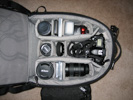
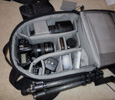


Lowepro Topload Zoom 1 - For a very limited SLR kit, it's hard to beat a small reverse-opening bag, and that's what this is. It sometimes accompanies bigger bags on trips, for convenience.
Lowepro Rezo 110 AW - This is a perfectly sized small bag for a Nikon V1 with 10/2.8, 18/1.8, and 30-110 lenses, along with an SB-N5 flash and an extra battery.
Lowepro Rezo 190 AW - I had this typical large reverse-opening shoulder bag for a short period of time, but quickly decided that I had no real use for a large shoulder bag, and sold it. A few years later I realized that every now and then I did need something like that, to carry around a flash and a couple lenses with the camera, so I got another one.
Lowepro Rezo 160 AW - While I found no use for a large shoulder bag, a small one is quite convenient in certain situations. I can take it by itself as I describe above, or along with a bigger bag on a longer trip for little side treks, which I did in St. Lucia. It's quite good for what it does.
Lowepro Slingshot 100 AW - The Slingshot 100 was Lowepro's first sling bag, and is a very convenient way to carry a small amount of gear. It can carry a few small lenses, but it's just about maxed out with my D800E and 24-70/2.8 combo. I have packed it inside a separate backpack on a couple recent trips, including Alaska and Maine, and used it for various side excursions with less than my full kit, and for that it works very well. One one trip to St. John, in a fit of madness, I tried to use the Slingshot 100 as my sole camera bag, packing it full of my D300, 16-85 VR, 35/1.8, and 60/2.8 micro, with my 70-300 VR strapped to its side in a lens case. That setup didn't work so well.
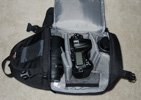
Lowepro Slingshot 200 AW - Once I saw how convenient the Slingshot 100 was, I figured that a bigger version would be even better! What I quickly realized is that as a sling bag gets heavier, the single-shoulder carrying approach becomes literally quite painful, so I sold it. Lowerpro even has a 300-level model, which seems kind of insane for a sling bag.
Lowepro Inverse 100 AW - In my continuing quest to combine the best of a pure backpack with more convenience for the camera, I tried this beltpack and quickly realized it was big and intrusive, particularly when combined with a backpack. It went back to the store.
Lowepro Versapack 200 AW - The Versapack looked like an interesting new approach, basically a backpack with the option to sling it over one shoulder and access the gear from the side. Unfortunately, the implementation was such that there was limited space for gear and the overall structure of the backpack was very flimsy and awkward. It went back to the store.
REI Trail 25 - This is a regular lightweight daypack, with only limited structure, and it's actually become my everyday work bag, usually carrying just my iPad, LX5, umbrella, and small items, but with room for my laptop in a slim case, notebooks, and a bunch of other stuff (even clothing on overnight business trips). On two "real" trips, one to St. John and one to Utah, I tried to use it as my main camera bag, with mixed results. On the St. John trip I tried stuffing various lenses into it in individual cases, with a tripod strapped to the side and the camera itself in my Topload Zoom 1, but on the whole it wasn't that convenient. For my Utah trip, I added the Rezo 160 and was even able to set up the Rezo hanging from the back of the Trail 25 for extra space, with the 70-200/2.8 in its OEM case inside the pack. Although the backpack was very comfortable, the setup wasn't that convenient, and the Rezo kind of flopped around. So much for that idea.


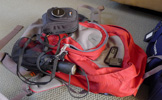
Clik Elite Medium Nature Pack - In a break from my usual pursuit of Lowepro products, I tried this interesting new option -- and it's a good one. Clik Elite has done the best job so far of combining a camera backpack with a daypack, with a lower compartment for camera gear, an upper compartment for "stuff," and a very robust and comfortable carrying system with both shoulder straps and a waist belt. The bag is big enough and adjustable enough to fit my large torso, the camera compartment is suprisingly large, fitting my D800E with 24-70/2.8 attached as well as my 70-200/2.8 VR I and 300/4 AF-S with 1.7 TC on either side of it, and it's even got a very generous weather cover that fits over the bag and all the stuff hanging off it.
The two main issues I have with this bag are 1) it's heavy, at more than 5 pounds by itself, and 2) the camera gear is only accessible from the front. It's still the best option I've found so far, and has gone on trips to Alaska, Las Vegas, and Maine as my primary camera bag. In the case of Alaska and Maine, I also brought the Slingshot 100 as a smaller, lighter option, which worked well -- plus I can stuff more gear in the Slingshot and it in turn into my REI daypack. The Clik Elite itself fits well in an overhead bin, and in a pinch under an airline seat, albeit at the cost of precious legroom.

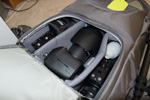

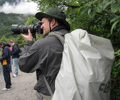
Lowepro Flipside 400 AW - On paper, this bag looks very good -- a big, roomy compartment for camera gear, an innovative reverse opening so only the outside of the backpack gets laid down on the ground (in the mud), and a big outside pocket for non-camera gear. Unfortunately, it just doesn't fit me -- for the waist belt to do it's job, I have to adjust the shoulder straps to near their limit, and the bag just flops around against my back. The outer pocket for non-camera gear looks big, but is actually cramped and doesn't hold that much stuff. I've used it locally on some hikes, but it's fallen out of favor and I've never taken it on a real trip.


Clik Elite Medium SLR Check Pack - Clik Elite's solution to immediate camera access with their bags is a chest pack. Unfortunately, even one of their smaller chest packs is a pretty big bag, and I just didn't like the whole set up. This one went back.
F-Stop Loka - So far, this looks like the perfect bag. It's lightweight, it's modular, it opens from the back side, it's got room for both camera equipment and other stuff, and it's got plenty of click straps, loops, and connectors for hanging various things off it in different places. I haven't used it much yet; my one criticism is that the support structure is slightly inferior to that on the Clik Elite.
I'm not sure it's possible to have a rear-opening camera bag with as awesome a support system as on the Clik Elite, so I can live with it. Otherwise it seems great. It's wonderful to be able to put the bag down easily and work with the gear inside. F-Stop uses a modular design that incorporates "Internal Camera Units" (ICUs), which are basically boxy self-contained carriers for camera gear, laid out like the insides of a
standard backpack, but in various sizes that can be inserted into or removed from their bags and backpacks. I got the Large and Medium Pro ICUs with the bag, but getting the large one installed was a chore, and I may return the medium one. The large ICU has plenty of space for lots of gear - it's shown here ready for air travel with a D800E with L-bracket and 24-70/2.8 attached, a 300/4 with 1.4 TC attached, a 70-200 f/4,
35/1.8 and 10.5 fisheye primes, an SB-800 flash, and a small Nikon 1 kit (V1 with attached 10/2.8 and FT-1 adapter), as well as a couple small items (memory card case and blower bulb). The outer views show it "ready for action" with an attached medium-sized tripod and head, or ready for air travel with a small tripod strapped on with no head.
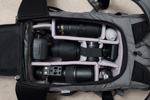
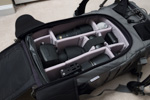


The Perfect Backpack - This bag has plenty of space for gear and plenty of space for other stuff, room for water bottles in easily-accessible mesh pockets, access to the camera gear both from the back of the pack (to keep the dirt on the outside) and the side (so I can quickly flip it around and get the camera), a spot on the side for my tripod, is very comfortable and fits me, and fits easily on airplanes. I was considering the Clik Elite Contrejour 35, but for now am going with the F-Stop Loka.
I also have a collection of individual lens cases of various sizes (Lowepro Lens Case 1M, 1S, 1N, 2, 4S, and 4), a couple Lowepro Bottle Bags (which are great), miscellaneous utility bags (Lowepro SlipLock Pouch 30 and 50 AW), and of course all of the mostly-useless OEM cases and lens bags that come with the gear. All of those Lowepro cases work together and can be attached to various bigger Lowepro and other bags to customize a particular outfit or be stuffed into other bags as needed.

